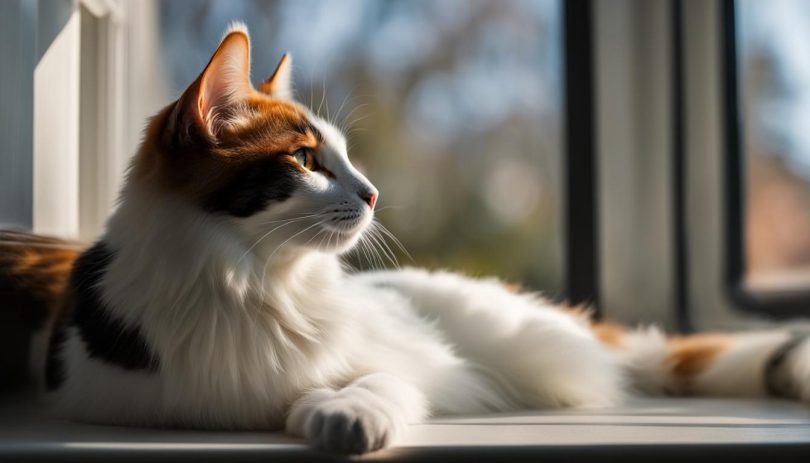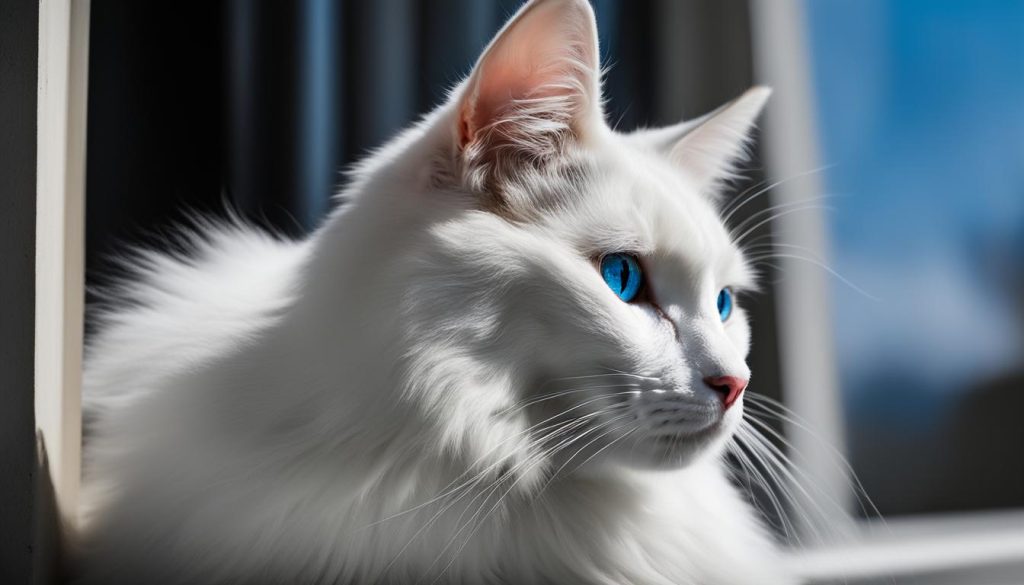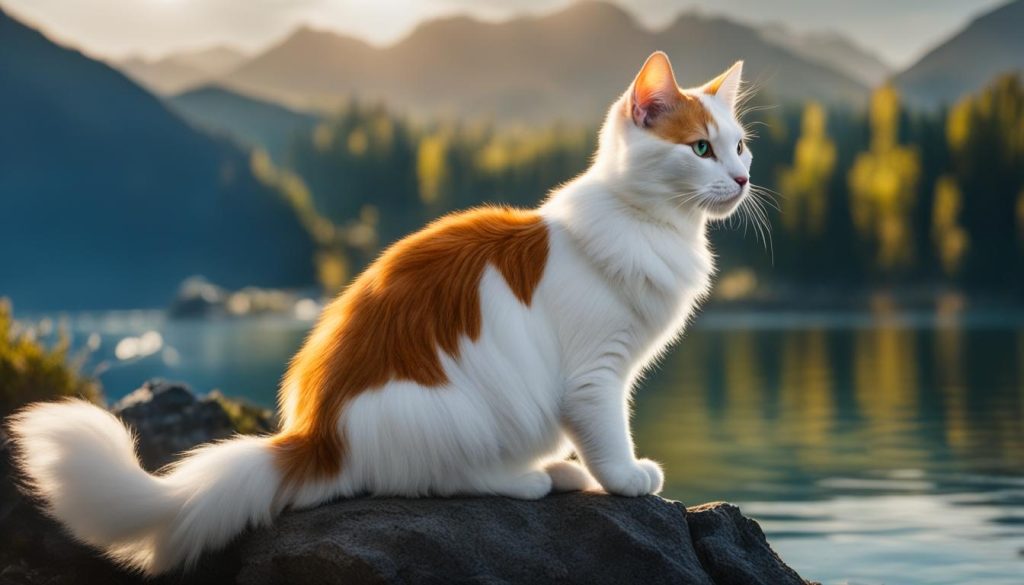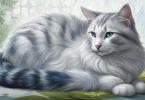I am excited to delve into the fascinating world of the Turkish Van cat, specifically the black and white variety. Known for their striking appearance and charming personalities, these cats have captured the hearts of many cat lovers around the globe.
The Turkish Van is a unique breed that originated in the Middle East and boasts an eye-catching coat pattern that is predominantly white with colored markings on the face and tail. These majestic cats are active and athletic, always ready for a climbing adventure or an exploration session in your home.
What sets the Turkish Van apart from other breeds is their love for water. Yes, you heard it right! These feline daredevils are often found splashing around in the sink or even taking a dip in the bathtub. Their affinity for water has earned them the nickname “swimming cats.”
Not only are Turkish Vans playful and adventurous, but they also have a loving and energetic personality. They enjoy the company of their human companions and get along well with other cats, dogs, and even respectful kids.
Key Takeaways:
- The Turkish Van cat is a stunning black and white breed with unique markings on the face and tail.
- These cats are known for their love of water and are often called “swimming cats.”
- Turkish Vans have an affectionate, energetic, and playful personality.
- They get along well with other pets and are great companions for active families.
- Their striking appearance and charming nature make them a favorite among cat lovers.
Turkish Van Cats as Pets
The Turkish Van cat breed is not only unique in its appearance but also makes for a wonderful pet. With their friendly, outgoing, and affectionate personality, Turkish Vans are well-suited for active families. These cats get along well with other cats, dogs, and even respectful kids. While they may not be lap cats, Turkish Vans enjoy being petted and picked up occasionally, forming a strong bond with their human companions.
Grooming a Turkish Van cat is relatively easy as they have a semi-longhair coat that naturally resists matting. Weekly brushing is usually sufficient to keep their luxurious coat looking sleek. Additionally, Turkish Vans love to play, climb, and explore, so providing them with plenty of toys and opportunities for physical activity is essential for their well-being.
When it comes to feeding, Turkish Vans have moderate energy levels and intelligence. Tailoring their diet to their age, energy level, and overall health is important for their nutrition. These cats are generally vocal and use their voice to communicate their needs. Shedding is moderate, although they may experience more significant shedding during seasonal changes.
The History and Origins of the Turkish Van Cat
The Turkish Van cat is an ancient breed with a fascinating history that traces back to the regions of central and southwest Asia, including present-day Iran, Iraq, and parts of the Soviet Union and Turkey. The breed gets its name from the city and lake of Van, which are located in this region. Turkish Van cats have been around for centuries, developing naturally in this area before being officially recognized as a distinct breed.
In 1955, the first Turkish Van cats were brought to England, and they made their way to the United States in 1982. Since then, they have gained recognition from cat associations such as the Cat Fanciers’ Association and The International Cat Association. Despite their rich history, Turkish Van cats remain relatively rare, even in their native place of origin.
“The Turkish Van cat has a long and storied history, originating in the ancient lands of central and southwest Asia. Its unique characteristics and beautiful coat have made it a cherished breed among cat enthusiasts.”
The origins of the Turkish Van cat are a testament to their resilience and adaptability. These cats have thrived in various climates and landscapes, including the harsh winters of Russia and the dry summers of Iran. Their ability to survive and thrive in these diverse environments is a testament to their sturdy nature and the selective pressures of their natural habitats.
| Characteristic | Description |
|---|---|
| Country of Origin | Turkey |
| Coat Length | Medium |
| Coat Color | White with colored markings |
| Eye Color | Ambere, blue, or odd-eyed |
| Weight | Up to 20 pounds |
| Lifespan | Up to 17 years |
The Turkish Van cat’s history and origins contribute to its unique characteristics and beautiful appearance. These cats have a rich cultural heritage and continue to captivate people around the world with their striking features and lively personalities.
The Unique Coat and Coloration of the Turkish Van Cat
Turkish Van cats have a distinctive coat that sets them apart from other breeds. Their coat is mostly white with colored markings on the head and tail, creating a striking contrast. The color patches can come in various shades, such as red, black, blue, tabby, or tortoiseshell, making each Turkish Van cat’s coat unique and visually captivating.
One of the defining characteristics of the Turkish Van coat is the pattern on the head, which ideally forms a symmetrical inverted V shape. The tail can also exhibit several colors, further enhancing the beauty of these felines. The coat is semi-longhair and has a luxurious texture that feels soft and resembles cashmere. This unique coat not only adds to the aesthetic appeal of Turkish Van cats but also provides them with natural protection against matting.
Turkish Van cats are also known for their exceptional eye colors. They can have amber eyes, blue eyes, or one of each, known as odd-eyed. This captivating feature adds to their overall charm and allure. The combination of the white coat, distinctive markings, and mesmerizing eyes makes the Turkish Van a visually stunning breed.
Table: Coat and Eye Color Variations in Turkish Van Cats
| Coat Color | Eye Color |
|---|---|
| White with red patches | Amber |
| White with black patches | Amber or blue |
| White with blue patches | Blue |
| White with tabby or tortoiseshell patches | Amber or blue |
| White with mixed color patches | Odd-eyed (one amber eye and one blue eye) |
This unique coat and eye color combination makes the Turkish Van cat a true work of art. Whether they are lounging in the sun or gracefully exploring their surroundings, Turkish Vans always stand out with their striking appearance.
Caring for a Turkish Van Cat
Taking care of a Turkish Van cat involves a few key aspects to ensure their health and well-being. From grooming to feeding and regular vet visits, these cats require attention and care tailored to their unique needs.
Grooming Turkish Van Cats
Turkish Van cats have a medium-length coat that is easy to maintain. They naturally resist matting, but regular brushing is still necessary to keep their fur looking sleek and free from tangles. Weekly brushing with a soft brush or comb is usually sufficient. During shedding seasons, you may need to brush your Turkish Van more often to remove loose hair. It’s also important to check their ears and clean them if necessary, trim their nails regularly, and provide dental care to promote good oral hygiene.
Feeding Turkish Van Cats
Feeding a Turkish Van cat should be based on their age, energy level, and overall health. Choose high-quality cat food that is specifically formulated for their nutritional needs. The diet should consist of a balance of protein, fat, and carbohydrates. It’s important to follow the feeding guidelines provided by the cat food manufacturer and avoid overfeeding to prevent obesity. Fresh water should be available at all times to keep your Turkish Van cat hydrated.
Regular Vet Visits
Veterinary visits are crucial for the health and well-being of your Turkish Van cat. Regular check-ups are recommended to ensure they are up to date on vaccinations and to monitor their overall health. Your veterinarian can also provide guidance on parasite prevention, such as flea and tick control. It’s important to address any health concerns promptly and follow your vet’s recommendations for preventive care and treatment. Regular vet visits contribute to the long and healthy life of your Turkish Van cat.
| Grooming | Feeding | Vet Visits |
|---|---|---|
| Regular brushing Ear checks and cleaning Nail trims Dental care |
High-quality cat food Balance of protein, fat, and carbohydrates Follow feeding guidelines Avoid overfeeding |
Regular check-ups Vaccinations Parasite prevention Prompt treatment of health concerns |
Turkish Van Cats: Myths vs Facts
Turkish Van cats are a unique and fascinating breed, often shrouded in myths and misconceptions. Let’s separate fact from fiction and uncover the truth behind these beautiful felines.
Myth: Turkish Vans are all swimming cats
“Not all Turkish Van cats enjoy swimming.”
The myth that all Turkish Vans are natural-born swimmers is not entirely accurate. While many Turkish Vans do have a fondness for water, not all of them are inclined to take a dip. Some Turkish Vans may prefer to watch the water from a safe distance or play with water toys rather than diving in themselves. So, while the swimming cat reputation is well-deserved for some Turkish Vans, it’s important to remember that every cat is an individual with its own unique preferences and personality.
Fact: Turkish Van coat patterns are distinct
“The coat pattern of Turkish Van cats is unique and specific to the breed.”
The coat pattern of Turkish Van cats is one of their defining features. The breed standard calls for a mostly white coat with colored patches restricted to the head and tail. This distinct coat pattern, with the colored patches forming a symmetrical inverted V on the head, sets them apart from other bicolor or van pattern cats. It’s important to note that not all cats with similar coat patterns are Turkish Vans, as the specific markings and coloration are exclusive to the breed.
Fact: Turkish Van cats are a rare breed
“Turkish Vans are considered a rare breed with a limited availability.”
While Turkish Van cats may not be as well-known as some other breeds, they possess a certain allure due to their rarity. Turkish Vans rank low in popularity among recognized breeds, making them a treasure for those who appreciate their unique characteristics. Finding a purebred Turkish Van kitten may require time and patience, as they are not commonly found in shelters or readily available for adoption. If you’re seeking a Turkish Van companion, be prepared for a journey that leads to a truly special feline.
https://www.youtube.com/watch?v=ycrYPBkUo_s
Turkish Van Cats: A Breed with Mystique and Rarity
The Turkish Van cat breed is shrouded in mystery and is known for its rarity. With a rich history originating in southeast Turkey and parts of Iran, Iraq, and Russia, these cats possess a unique and captivating appearance. They have a glistening chalk-white body with limited color patches on the head and tail, creating a striking contrast that sets them apart from other breeds.
The Turkish Van’s coat is a medium-length, cashmere-like texture, adding to its allure. The tail of a Turkish Van cat has a distinct brush-like appearance, enhancing their elegance and grace. Their sturdy and well-proportioned bodies showcase their natural athleticism and beauty. These cats have a slow maturity rate, reaching their full size over several years. With a lifespan of up to 17 years, Turkish Van cats can be cherished companions for a significant portion of their owners’ lives.
The rarity of Turkish Van cats adds to their appeal. Recognized by various cat associations, including the GCCF and CFA, they are considered a valuable find. Their limited availability and unique features make them a sought-after breed for cat enthusiasts and collectors alike. Whether encountered through adoption or at a cat show, the opportunity to appreciate their mystique and splendor is a chance to experience the wonder of this rare and beautiful feline.
| Turkish Van Cat Breed History | Turkish Van Cat Breed Description | Turkish Van Cat Rarity |
|---|---|---|
| The Turkish Van breed originated in southeast Turkey, Iran, Iraq, and Russia. | Turkish Van cats have a glistening chalk-white body with limited color patches on the head and tail. They have a medium-length, cashmere-like coat and a distinctive brush-like tail. | Turkish Van cats are considered rare due to their limited availability and distinct features. |
5 Fascinating Facts About Turkish Van Cats
Turkish Van cats are not only known for their striking appearance but also for their fascinating characteristics. Here are five intriguing facts about these unique felines:
- Eye-catching Coat Pattern: The most distinctive feature of Turkish Van cats is their coat pattern. They have a piebald gene that gives them a beautiful combination of white fur with colored patches on their heads and tails, creating a striking visual contrast.
- Enchanting Eye Colors: Turkish Vans have captivating eye colors that add to their allure. You can find them with shimmering amber eyes, mesmerizing blue eyes, or odd-eyed, which means each eye has a different color, such as one blue and one amber eye.
- Genetic Marvels: The piebald gene responsible for the Turkish Van’s unique coat pattern is considered a genetic marvel. It is believed to have originated in this breed and is also found in other animals, making Turkish Van cats even more exceptional.
- A Rare Breed: Turkish Van cats are known for their rarity. Finding a purebred Turkish Van kitten can be a challenge due to their limited availability. Their uniqueness and scarcity only add to their desirability as cherished companions.
- Captivating and Cherished: Turkish Van cats are truly remarkable pets. Their enchanting appearance, playful personality, and affectionate nature make them beloved companions for those fortunate enough to welcome them into their homes.
These fascinating facts highlight the allure and wonder of Turkish Van cats. Their eye-catching coat pattern and captivating eye colors set them apart from other breeds. The genetic marvel of the piebald gene adds to their allure, making them a rare and cherished companion. Turkish Van cats truly are a treasure in the world of feline beauty.
| Turkish Van Cat Facts | |
|---|---|
| Coat Pattern | Piebald gene creates a white fur coat with colored patches on the head and tail |
| Eye Colors | Amber, blue, or odd-eyed (one blue eye and one amber eye) |
| Genetic Marvel | Piebald gene originated in Turkish Van cats and is found in other animals |
| Rarity | Turkish Van cats are a rare breed with limited availability |
| Charming Companions | Playful, affectionate, and enchanting in both appearance and personality |
Understanding Turkish Van Cats and Lookalikes
Turkish Van cats possess distinct characteristics that set them apart from lookalike cats. While other cats may share a similar coat pattern, it is important to recognize that they are not purebred Turkish Vans. These unique felines have specific traits that make them truly exceptional.
One of the distinguishing features of a Turkish Van cat is its coat pattern. Turkish Vans have a beautiful white fur with colored patches on their heads and tails. This coat pattern is exclusive to the breed and is different from other bicolor or van pattern cats. It adds to their charm and allure, making them stand out in the feline world.
To further recognize a true Turkish Van, it is essential to understand their rarity. Turkish Vans are considered a rare breed, and finding a purebred Turkish Van in a shelter or by chance is highly unlikely. However, cats with a similar coat pattern can still be stunning companions. While they may not possess the same lineage and history, these lookalike cats can bring joy and companionship to their owners.
When considering a Turkish Van or a lookalike cat, it is crucial to understand the distinction between the two. Adopting a lookalike cat can still provide a unique and charming pet, but it is important to be aware of the characteristics and traits characteristic of genuine Turkish Van cats. Whether you choose a Turkish Van or a lookalike, both can bring love and happiness to your home.
Recognizing Turkish Van Cats
Recognizing a Turkish Van cat involves paying attention to specific traits and behaviors. Here are some key characteristics to look for:
- The distinctive coat pattern with colored patches on the head and tail
- The unique eye colors, including amber, blue, or odd-eyed
- The playful and adventurous nature
- The love for water, although not all Turkish Vans are avid swimmers
- The medium to large-sized body with a sturdy and graceful physique
By understanding these distinguishing features, you can better identify a Turkish Van cat and appreciate their individuality.
| Turkish Van Cat vs. Lookalike Cats | |
|---|---|
| Turkish Van Cats | Lookalike Cats |
| Distinct coat pattern with colored patches on the head and tail | Similar coat pattern, but not purebred Turkish Vans |
| Unique eye colors (amber, blue, or odd-eyed) | Varied eye colors depending on the breed |
| Playful and adventurous nature | Different personalities depending on the individual cat |
| Love for water (although not all Turkish Vans are avid swimmers) | Varied preferences for water depending on the personality |
| Medium to large-sized body with a sturdy and graceful physique | Varied body sizes depending on the breed |
Conclusion
Having explored the uniqueness of the black and white Turkish Van cat, it is clear that this breed is truly one-of-a-kind. With their distinctive coat pattern, love for water, and playful personalities, Turkish Van cats bring a touch of splendor to any home.
As a rare breed, owning a Turkish Van cat is a special privilege. Their rich history and mystique add to their charm and allure. While they may not be lap cats and require some grooming, their affectionate nature and energetic presence make them perfect companions for active families.
If you’re lucky enough to encounter a Turkish Van cat, whether through adoption or at a cat show, you’ll have the opportunity to appreciate their beauty, intelligence, and engaging personality. The black and white Turkish Van cat is a true treasure within the feline world, and owning one can be a truly rewarding experience.
FAQ
Are Turkish Van cats hypoallergenic?
No, Turkish Van cats are not hypoallergenic. While their coat may naturally resist matting, they still produce allergens that can cause allergies in sensitive individuals.
How often should I groom my Turkish Van cat?
Turkish Van cats have a moderate shedding level and require weekly brushing to keep their coats looking sleek. Additional brushing during shedding seasons may be necessary.
Do Turkish Van cats get along with other pets?
Yes, Turkish Van cats are known to get along well with other cats, dogs, and respectful kids. They have a friendly and outgoing personality.
Do Turkish Van cats enjoy being picked up and cuddled?
While Turkish Van cats are not lap cats, they do enjoy being petted and occasionally picked up. They are affectionate and enjoy human interaction.
How long do Turkish Van cats live?
Turkish Van cats have a lifespan of up to 17 years with proper care and a healthy lifestyle.
How rare are Turkish Van cats?
Turkish Van cats are considered a rare breed, even in their native place of origin. Finding a purebred Turkish Van kitten may require some patience and research.
Are Turkish Van cats good for active families?
Yes, Turkish Van cats are great companions for active families. They have an energetic and playful personality, and they enjoy climbing, jumping, and exploring.
Do Turkish Van cats require a lot of grooming?
No, Turkish Van cats have a coat that naturally resists matting, and they only require weekly brushing to keep their coats looking sleek. They have minimal grooming needs.
Can Turkish Van cats swim?
While Turkish Van cats are often called “swimming cats” due to their love of water, not all Turkish Vans are avid swimmers. Some may enjoy water more than others.
Where did the Turkish Van cat originate from?
The Turkish Van cat originated in the Middle East, particularly in the region of central and southwest Asia, including present-day Iran, Iraq, and parts of the Soviet Union and Turkey.








